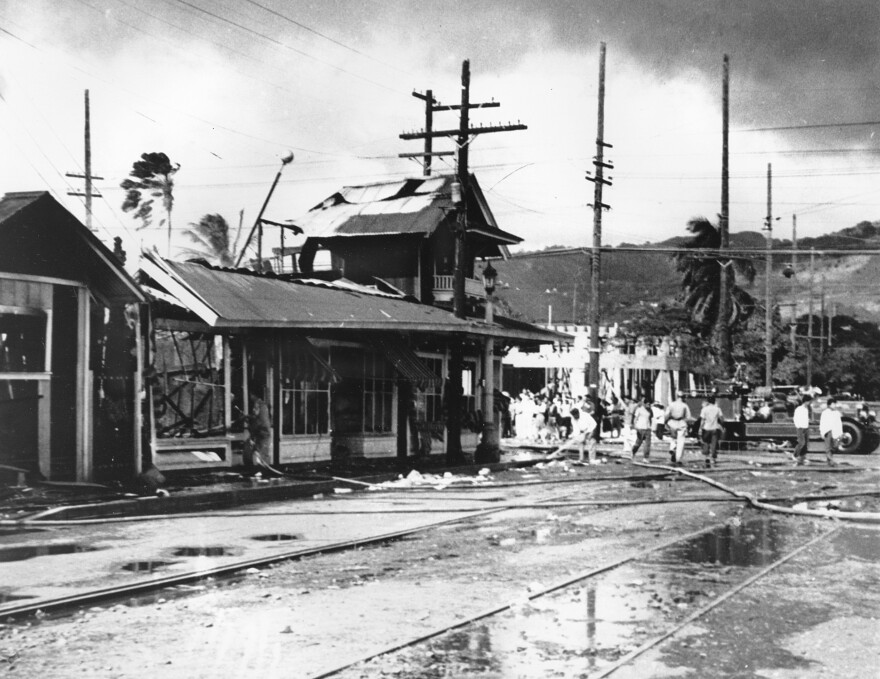Looking ahead to the new year, you might consider what this season was like 81 years ago in Hawaiʻi. It was a time of rationing, blackouts, and media censoring.
Along with our partners at the University of Hawaiʻi's Center for Oral History, we're bringing you memories of that period — and the voices of those who experienced it.
Ethnic studies professor Ty Kāwika Tengan shares the thoughts of two people who lived under martial law, Rosaline Calasa Ventura and Richard H.Y. Chun
Born in 1917, Maui resident Rosaline Calasa Ventura said her husband was a member of the Provisional Police on Maui before they moved to O‘ahu for civilian defense jobs. In this 1993 interview, Ventura remembered the pervasive food and supply shortages that characterized life during the war.
Ventura: There were shortages and everything was rationed. Even when it came to bobby pins. Bobby pins, you'd have a line from here almost to the community center up there. People all in line waiting for bobby pins. The two things that we had to stand in line for hours would be poi and meat. Those two things we had to get out in line very early in the morning. If it was for poi, it would be down on Queen Street, Chinatown. And that's where they used to have the poi sales and all different types of local foods. When the poi man finally came, well the place would be packed. And you just keep your fingers crossed. "Let there be at least a bag of poi that I can take home." When we went down to Metropolitan for meat, we were lucky when we would go through the whole line and get inside, that there would still be something in the showcases. And we were happy when we were able to go home with shinbone because that was horrible. People used to get there, I really don't know how early, because a lot of them had tiny little mattresses and a blanket. That meant that they had spent most of the night there. But that's the only way we could get any of those things.
While many Hawai‘i families struggled with food and supply shortages, they also were confronted by the possibility of another aerial attack. Authorities encouraged families to build air raid shelters at home for their protection.
O‘ahu resident Richard H.Y. Chun, born in 1926, worked as a part-time golf caddy when Pearl Harbor was bombed and witnessed Japanese planes attacking Wheeler Field. In this 1993 interview, Chun recalled the challenges of constructing the air raid shelter that he and his brothers built in their backyard.
Richard H.Y. Chun: My two younger brothers and I, we spent about a week digging up this air raid shelter which was about 7 feet deep, 4 feet wide, and about 20 feet long. Then my oldest brother was working for the Pineapple Research Institute, brought home eucalyptus tree and branches and we laid it across the top. And he also brought home the tar paper and we covered that over and put a canvas on top of that, and then put the dirt over it and piled it up high. And on top of the air raid shelter, we planted potatoes. We lined the air raid shelter with heavy cloth, 'cause lumber wasn't that easy to get so we had one entrance going in and another one coming out. Of course you know that thing being damp and whatnot, there's a lot of mosquitoes so you got to get rid of the mosquitoes. There's only one time that we used it. When they had the battle at Midway, the alarm sounded and told us to take cover. I look over there and we saw these B-17 bombers going to the northwest, so we were saying, "Oh, something's coming up." I guess they didnʻt know whether the planes or the ships were going to come over here because Midway is only about 1,300 miles away from Hawaiʻi. I guess when the battle was there, they called off the alarms. So we got out of there.
———
This collaboration is supported by the SHARP Initiative of the National Endowment for the Humanities through the American Council of Learned Societies.






